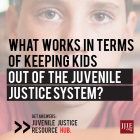
What is Re-entry and Aftercare for Youth?
|
What do you think should happen when a kid is incarcerated? If you’re like most Americans, you think rehabilitation should be a top priority for youth correctional facilities, according to a recent poll conducted by the Pew Charitable Trusts. But are kids actually getting what they need in facilities to ensure they don’t commit new crimes when they return home? Evidently not:
Two-thirds of these youth don’t return to school after their release from secure custody. Even though parents and families are the most important factor in determining youth success in reintegrating into the community, only one in three families report being included in any release plans made for their children by juvenile facilities.



